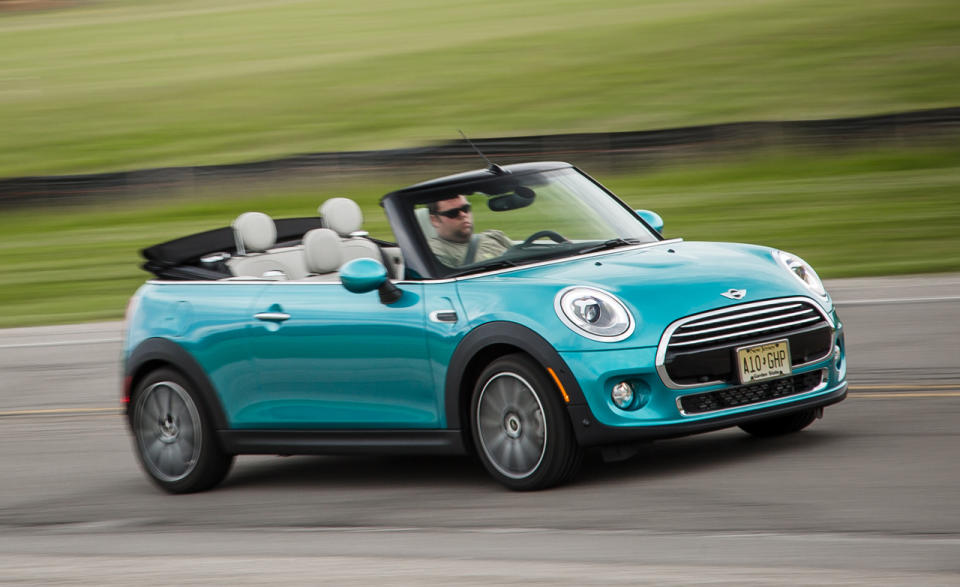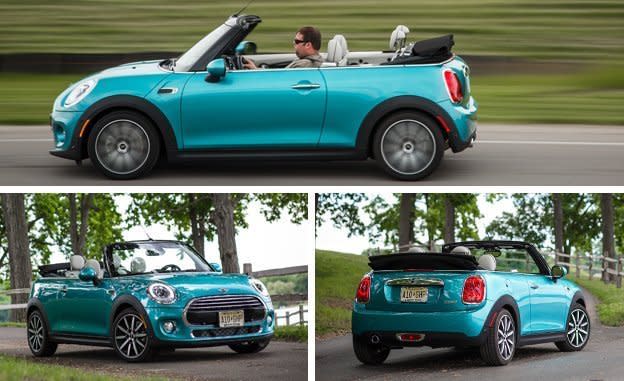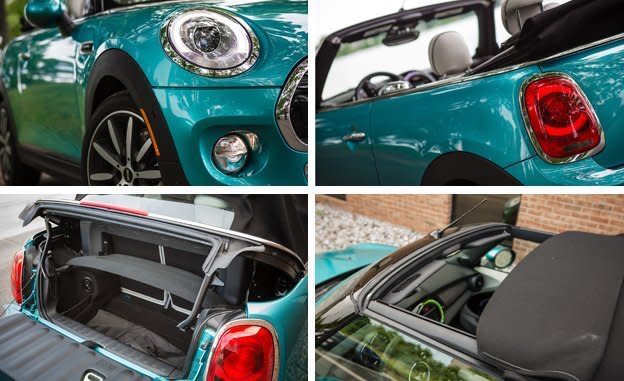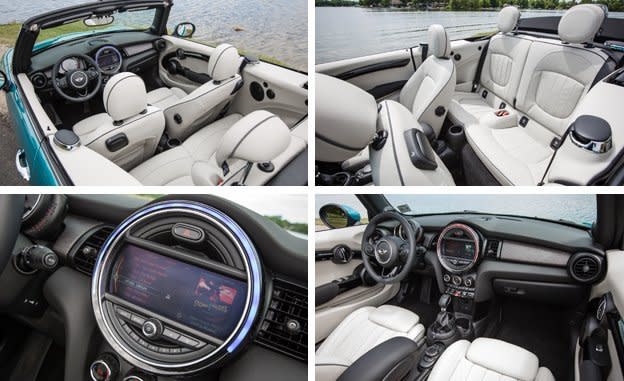2016 Mini Cooper Convertible Automatic

They may be impractical, frivolous seasonal toys, but convertibles are far from dead. Quite the contrary: There are no fewer than nine droptops available starting at or below the average transaction price for a new car in the United States. That bogey currently hovers just above $33,000, a mark the entry-level Mini Cooper convertible undercuts handsomely with a $26,800 base price.
But . . .
With an option sheet overflowing with personalization choices, the Mini can be loaded up past $41,000. That’s get-your-head-checked money for a base Cooper convertible, the model powered by a 134-horsepower turbocharged three-cylinder engine, not the 189-horsepower, four-cylinder Cooper S. Our test car didn’t crack $40,000, but its window sticker bore a rich $37,150 price tag, nearly $3000 more than a 2016 Cooper S convertible we recently tested.

Credit the $5000 Fully Loaded package, an amalgamation of three individual option bundles, for most of the inflation. It adds proximity-key entry, a wind deflector, auto-dimming mirrors, heated front seats, a Harman/Kardon audio system, satellite radio, navigation with real-time traffic information, a backup camera, dynamic damper control, sport seats, and LED headlights. Nifty 17-inch wheels and parking sensors added $500 apiece, chrome exterior trim and a storage package each piled on $250, and the six-speed automatic replaced the standard six-speed manual transmission for $1250.
The only worthwhile options, to us, were the cosmetic bits. The attractive Caribbean Aqua paint ($500), Satellite Grey leather seats ($1750), and Cottonwood interior trim ($350) gave off a Malibu Barbie vibe, and the car wouldn’t look out of place on the crushed gravel driveway of a Malibu, California, beach home. The dynamic damper control, which adjusts the suspension’s firmness depending on the selected drive mode, felt similarly worthwhile. It came in the Fully Loaded bundle but can be had in the less expensive Sport package ($1750). The dampers chopped a noticeable amount of, well, chop from the often abrupt ride quality we find in Minis, a consequence of their short wheelbase, run-flat tires, and a suspension tuned to prioritize handling. The small-for-a-modern-Mini 17-inch wheels certainly helped (the Sport package settles for 16-inchers, and we’d avoid the 18-inch option). The ride might have felt even smoother if not for the standard run-flat tires, which slap over highway expansion joints and medium-size dried leaves.
Mini Is as Mini Does
Whether or not you exercise self-restraint upon encountering the Mini’s online configurator, which boasts over 10 million possible build combinations, the Cooper convertible has a relatively light curb weight, firm suspension tuning, and quick steering. Even its above-average objective performance measurements—0.84 g on the skidpad and a 163-foot stop from 70 mph—don’t fully convey the Mini’s eager-puppy-dog character on the road.

Similarly, the 7.5-second zero-to-60-mph time doesn’t tell the turbo three-cylinder’s whole story. The little engine feels breathless only for the first foot or so after accelerating from a standstill, after which the 162 lb-ft of torque hits and propels the Mini forward with gusto. Our test car’s six-speed automatic transmission is the ideal boulevard companion but also grabs gears quickly and intelligently in Mid (normal) and Sport modes (Green mode dulls its responses in the name of fuel economy). Our sole complaint about this transmission is its lack of steering-wheel shift paddles; to manually select gears in the non-S Cooper automatic, you’re stuck rocking the shift lever fore and aft.
Going nuts with options also won’t ameliorate the Cooper’s inherent Mini-isms, weaknesses that are exclusive to the brand’s modern wares. Our convertible’s notably flexible structure accentuated the symphony of interior creaks and rattles that’s fast becoming a hallmark of modern Minis—and this example had just 1600 miles on its odometer. Unlike in other Minis, here you can lower the roof, and the racket flies away with the wind. This solution requires some effort, as the power top takes 18 seconds to lower and requires a switch mounted on the windshield header be held down during the entire process. Lowering the top using the key fob, from outside the car, is slicker and requires less of a reach.
Interior ergonomics are as haphazard as in other Minis, with switchgear buried in hard-to-see locations and an armrest installed without consideration to where the human elbow is located. Quirks such as the pie-shaped housing for the central display and the bottom-hinged trunk lid that swings open like a pickup truck’s tailgate are almost endearing, as if Mini’s German corporate benefactors searched for ways to grasp at plucky British-car stereotypes without building a car that regularly lunches its electrics or hemorrhages oil. Others are less successful, like how the Cooper’s switchgear appears to have been shot at the dashboard from a blunderbuss—odd, given how the original Mini’s cabin was a model of simplicity. It was cute in the first BMW-revived Mini in 2001; 15 years on, the cheekiness is somewhat less charming, and even the fussy Fiat 500C’s interior works better. The Volkswagen Beetle’s functional cabin layout is almost boringly intuitive by comparison.

Sunny Side Up
These Mini-isms may dissuade many, aside from the most ardent cuteness chasers or those who require top-down style and driving satisfaction, which is a shame because the Cooper is otherwise well designed. The size increase of the third-generation, BMW-developed Cooper imbues even the convertible variant with surprising utility. Its 4.1-inch overall growth spurt in length and its 1.1-inch-longer wheelbase help accommodate medium-size humans in the back seat, as long as the front passengers are of similar size and nobody minds that the power top mechanism forces the two rear seats close together, pinching shoulder room. With the top up, there’s 7.6 cubic feet of cargo space, enough for a carry-on roller bag and a small duffel.
We’re entertained by Mini’s Openometer, a digital chronograph function that tracks, down to the minute, how much time the roof spends in its lowered position. More practically, we enjoy the cloth top’s sunroof function, which allows the panel above the front occupants to slide open without folding down the entire top. The Mini is undeniably adorable, and it delivers a far sportier driving experience than equivalent base-model versions of its retro rivals, the Fiat 500C and the Volkswagen Beetle. Those shopping for a budget convertible could do well here by skipping most of the option list; anyone willing to spend as much as this car’s sticker price, though, would be better advised to start with a Cooper S.
Specifications >
VEHICLE TYPE: front-engine, front-wheel-drive, 4-passenger, 2-door convertible
PRICE AS TESTED: $37,150 (base price: $26,800)
ENGINE TYPE: turbocharged and intercooled DOHC 12-valve inline-3, aluminum block and head, direct fuel injection
Displacement: 91 cu in, 1499 cc
Power: 134 hp @ 4400 rpm
Torque: 162 lb-ft @ 1250 rpm
TRANSMISSION: 6-speed automatic with manual shifting mode
DIMENSIONS:
Wheelbase: 98.2 in
Length: 151.1 in
Width: 68.0 in Height: 55.7 in
Passenger volume: 76 cu ft
Cargo volume: 8 cu ft
Curb weight: 2981 lb
C/D TEST RESULTS:
Zero to 60 mph: 7.5 sec
Zero to 100 mph: 24.6 sec
Zero to 110 mph: 35.1 sec
Rolling start, 5–60 mph: 9.1 sec
Top gear, 30–50 mph: 4.4 sec
Top gear, 50–70 mph: 5.4 sec
Standing ¼-mile: 16.0 sec @ 85 mph
Top speed (drag limited): 124 mph
Braking, 70–0 mph: 163 ft
Roadholding, 300-ft-dia skidpad: 0.84 g
FUEL ECONOMY:
EPA city/highway driving: 27/37 mpg
C/D observed: 28 mpg

 Yahoo Autos
Yahoo Autos 